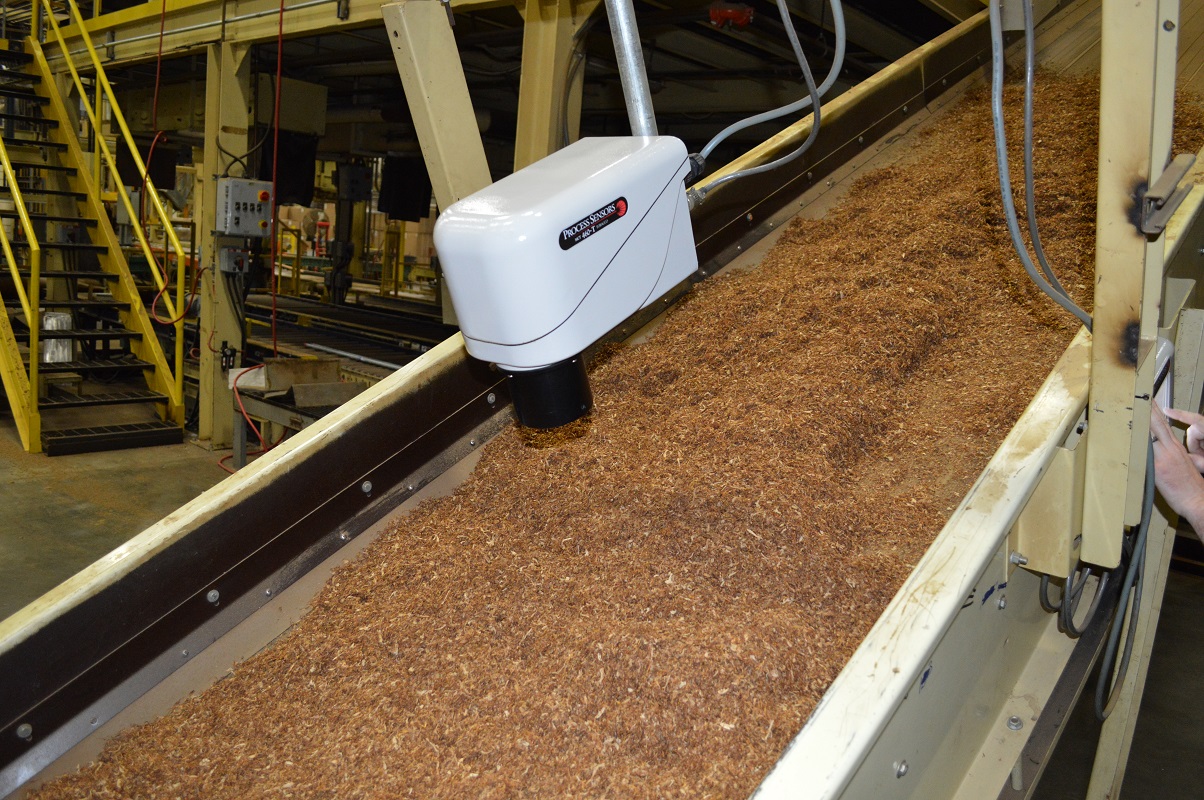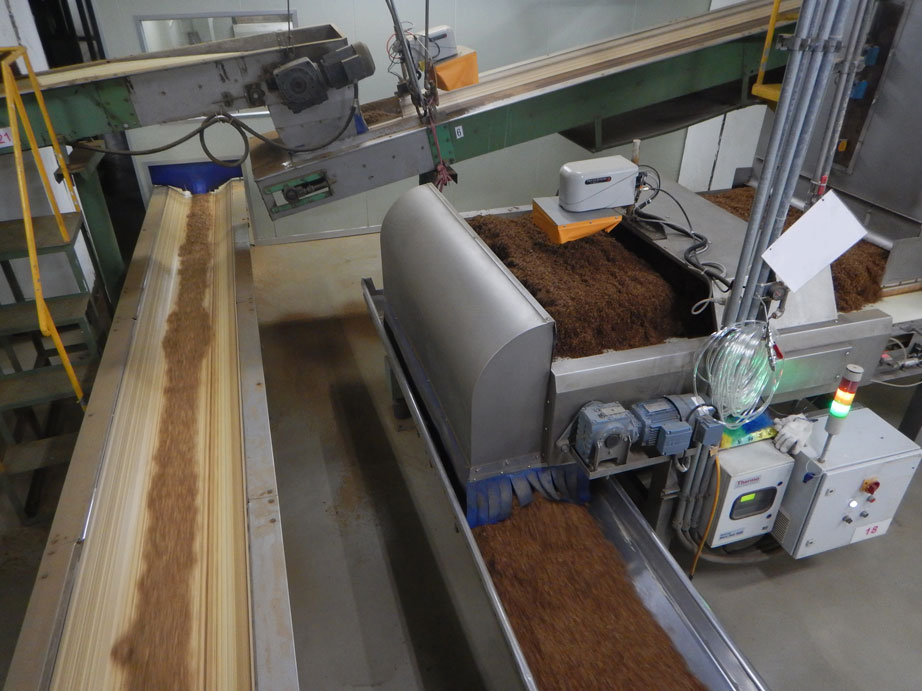-
Industries & Applications
-
Products
-
Support
- Request a Demo
-
What's New
- Company
- Contact
- +1-774-399-0461
Primary Tobacco Processing Moisture Measurement & Control
Producers grow over 7.5 million metric tons of tobacco a year. Different types of tobacco are treated in primary processing plants to achieve a final homogeneous blend for filling 5.5 trillion cigarettes. The treatments include: conditioning, casing, toasting, re-ordering, rolling and cutting, expansion and drying. Optimal moisture levels must be maintained prior and post treatment to attain proper specifications and optimize efficiency.
Tobacco Processing
Specific treaments are applied depending on the variety of cured tobacco being processed.
Air Cured (Burley) Tobacco
Bales of the burley tobacco are opened and conditioned using Direct Cylinder Conditioning (DCC). DCC injects steam and water into the rotating drum making the tobacco suitable for the subsequent mechanical handling. The Virginia tobacco then goes through a flavoring process called casing. Flavorings and sugars are applied to the tobacco using a rotating drum to enhance the natural taste. From here the tobacco is toasted in a wide flat bed dryer which further changes the appearance of the tobacco and determines the final smoke flavor. The tobacco is now dry and brittle, so using another conditioning cylinder (re-ordering cylinder) the tobacco is re-moistened prior to blending.
Flue Cured (Virginia) Tobacco
Bales of the Virginia tobacco are opened and conditioned using Direct ConditioningCylinder (DCC). DCC injects steam and water into the rotating drum making the tobacco suitable for the subsequent mechanical handling. The higher moisture burley passes on to a flavoring process called casing. Flavorings and sugars are usually spray cased onto the tobacco using a rotating drum to enhance the natural taste. The tobacco now goes on to blending.
Sun Cured (Oriental) Tobacco
Bales of the oriental tobacco are opened and conditioned using Direct Conditioning Cylinder (DCC). DCC injects steam and water into the rotating drum making the tobacco suitable for the subsequent mechanical handling. The tobacco now goes on to blending.
Dry Ice Expanded Tobacco (DIET)
Dry Ice Expanded Tobacco improves smoking quality and reduces tar and nicotine in cigarettes. Processed Tobacco is submerged and soaked in liquid carbon dioxide. After soaking the residual liquid is drained and reused. The liquid carbon dioxide in the tobacco cells turns to dry ice when the system is unpressurized. The tobacco is then heated, increasing the volume of the tobacco up to 140%. At this point the moisture is very low (1-3%) and so it must be conditioned with moisture to produce a product that can be blended. Care must be taken to not over-wet the DIET at this point, as the expanded structure could collapse reducing the filling volume.
Reconstituted Tobacco
Scraps off from the process lines and tobacco dust are collected and used to make reconstituted tobacco sheet. The tobacco sheet is shredded and added to the finished blend.
Tobacco Stems
Bales of stems are opened and conditioned to a higher moisture using a rotating steam drum conditioner. The softened stems are rolled and flattened to more closely resemble a leaf. After this process the stem is cut to the desired shape and then casing is applied to get the desired flavor characteristics. The flattened and cut stems are expanded by heating with steam, and the moisture level in the expansion process determines the degree of expansion of the stem. The final stem is then dried to the desired moisture level to add to the final blend.
Blending
Tobacco from the process lines are brought together in a blending drum to create the final blend as per the manufacturer/brand. Once blended, the tobacco is ready for the final stage of processing and manufacture of finished tobacco products.
Quality Parameters and Measuring Points
Moisture
Tobacco processing requires moisture control at every stage of the process. Proper moisture control is critical to maintain the quality of the tobacco and allows it to hold up to the mechanical aspects of the process. The correct moisture minimizes waste and maximizes the filling volume of the finished cigarette. Tobacco processing is highly automated, and at critical measurement points Process Sensors Corporation (PSC) MCT460-T moisture analyzers send measurements to Programmable Logic Controllers (PLC) to ensure specifications are being met throughout the process. Finished moisture in the tobacco should be around 12.5-13.5% but the stages in the process require different moisture ranges:
- Burley and Virginia Tobacco 10-15%
- Exit of Burley and Virginia Conditioning cylinders 14-16%
- Exit of Burley Casing Cylinder 28-32%
- Exit of Burley Toaster 18-20%
- Exit of Virginia Casing Cylinder 20-22%
- Cut rolled stem (exit cutters) 15-30%
- Exit of Stem Conditioning cylinders 35-50%
- DIET 3-15%
- Reconstituted Tobacco 12-20%
Temperature
Temperature may also be monitored to further analyze the effectiveness of drying and conditioning. This measurement can be a closed-loop control to optimize efficiency.
Measuring Points
The MCT460-T Tobacco Moisture Analyzer from PSC can be installed at the entrance or the exit of the conditioning cylinders and dryers to provide real-time moisture readings. Other measurement points in the process include the exit of the casing cylinder, DIET line, reconstituted line and stem line. Temperature measurement can be added as an option to the MCT460-T for further control.
Closed-loop process control can be used to finely control tobacco moisturizing and drying using the MCT460-T standard 4-20mA/0-10v analog or optional digital output (ProfiNet, ProfiBus, Ethernet IP, Modbus TCP, DeviceNet). The sensor is mounted 8 to 10 inches above product and ideally mounted at a point where product is tumbled onto a conveyor or between two conveyors so the MCT460-T is seeing fresh product.
Value and Quality
Moisture control is critical throughout the Primary Tobacco Processing plant from incoming tobacco bales to the finished blend. The PSC MCT460-T ensures proper moisture measurement for closed loop control in all parts of the process, ensuring optimized processing efficiency and a high quality, consistent tobacco product.
To learn more about how Process Sensors can optimize your primary tobacco processing operation, please fill out the contact form below.